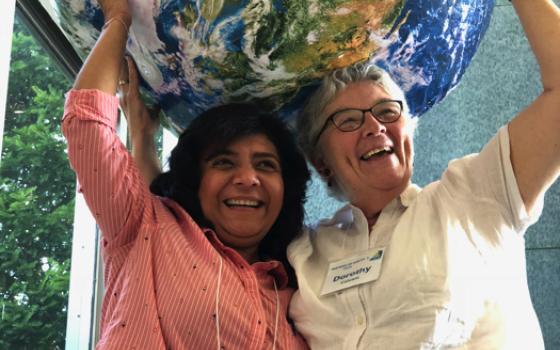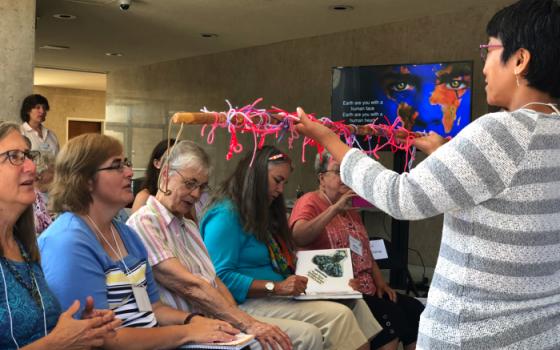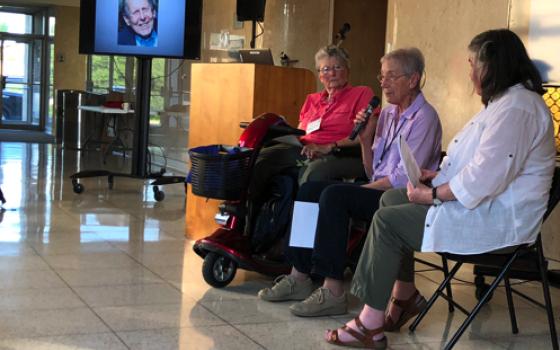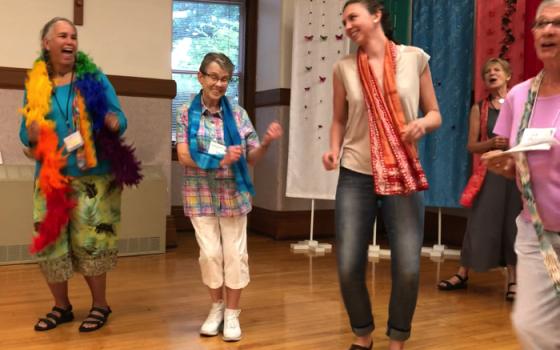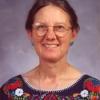How to Face the Mess We're in without Going Crazy, the subtitle of Joanna Macy's book Active Hope, aptly describes the time many of us feel immersed in this summer of 2018. It was also the inspiration for the Sisters of Earth gathering that took place July 12-15 at Mount Saint Joseph, home of the Sisters of Charity in Cincinnati, Ohio.
The conference is held every other year. Begun in 1994 through the inspiration of several U.S. and Canadian Catholic sisters, this informal network includes women of all ages — a means for women engaged in diverse professions to explore the new cosmology and its implications for a new and emerging worldview; to address concerns about the ecological/spiritual crises of our times; and to support one another in healing the human spirit and restoring Earth's support systems.
The Cincinnati gathering location was chosen partly because of the ancestral inspiration of Sister of Charity Paula Gonzalez, who promoted solar power and sustainability projects and teachings throughout the Catholic world. This year, nearly 100 women from the United States and Canada began by remembering Sister Paula and other guiding ancestors.
A visit to the cemetery where Paula is buried and a circle of remembering and dance set in motion a weekend filled with tears, laughter and inspiration. For three days we explored the theme, "Sharing the Wisdom, Shaping the Dream: Creating the Future We Want."
The vision of Sisters of Earth includes four elements of Active Hope: gratitude, pain for the world, seeing through new eyes, and bringing forth something new. Mercy Sr. Jan Stocking and Diza Velasco, two directors of Rockhaven Ecozoic Center in House Springs, Missouri, guided us through an experiential day focusing upon each of these four elements.
We combined the wisdom of Active Hope and the Awakening the Dreamer program, asking: Who are we? Where are we? How did we get here and what is possible? And — where do we go from here?
Sisters of Earth are very engaged in the world's suffering and realities of climate change. In a "Despair Ritual" we owned the pain of the world, and entered into anger, despair, sadness or fear, in order to be open to creative ways forward. I was really moved when the youngest woman in the group stepped to the circle, lifted the stone of fear, and bravely said, "I am afraid I will not have the strength to bear all of the suffering of the world that lies ahead in my lifetime."
Rituals of song, dance, anointing, and blessing honored such moving moments of the weekend. Composer and performer Joyce Rouse masterfully wove her music into our hearts and helped create some boisterous laughter at a Saturday night of song, dance and acting. She wrote a song for Sisters of Earth, called "A Life Well Lived," which reflects much of the wisdom shared over the weekend — ranging from bio-mimicry to dismantling the Doctrine of Discovery.
We shared inspiring stories of the work of Sisters of Earth:
Sisters of Charity of Cincinnati Marge Kloos and Mary Bookser described how their community is following Paula's inspiration by living into the meaning of transformational community life and the common good. They are changing the witness and the look of their campus through education, and by addressing climate change with sustainable technologies: geo-thermal, energy efficiency measures, replacement of 25,000 lights with LEDs, and installing a first solar array for six of their sisters' residential homes. They are saving thousands of tons of carbon emissions and sending excess energy to their utility company six months of each year.
The Sisters of Charity of Seton Hill in Greensburg, Pennsylvania, with their extended community and school children, are getting their hands dirty with a garden project. Sr. Barbara Ann Smelko said, "Two weeks after planting potatoes, seeing green shoots emerge in the field was the most thrilling and exciting thing any of us had witnessed in a long time."
Potatoes have become a community affair with young people harvesting, elder sisters sorting and cleaning, and volunteers building wooden crates to transport the harvest to a local food bank. Bat houses, butterfly gardens, an Amish-built garden shed and now onions stand witness to a spiritual community in physical terms — and to Mother Seton's theology: "Nature speaks to us in God's design."
A 2000 assembly and a study of cosmology and feminist cosmology over the years pushed the Sisters of Charity of Nazareth, Kentucky, an international community (based in the United States, India, Botswana and Nepal), to "scrutinize our lifestyles where we live", said Sr. Susan Gatz.
To help them reach a 2017 goal of zero emissions, they developed principles to guide decision making: protecting Earth and creatures; developing eco-consciousness; caring for the poor and marginalized, especially women; repurposing/relinquishment for mission; and collaboration.
Caroline Cromer, their sustainability director, helps the community implement numerous projects sprung from their years of reflection: a conservation easement on property in Pennsylvania; putting aside carbon offset money from travel to plant trees on their property in all of the countries they serve; bio-gas production and the creation of a plastic-free zone in their Indian community.
Through Caroline, the community is purchasing electric vehicles and battery-run lawn mowers; restoring native habitat; and discovering ways to address medical waste in their sisters' elder care facility. They are also part of a "best practice" collaborative with Loretto, Dominican, and Charity Sisters and other community partners.
Anne Simons-Bucher, filling in via Skype for Joanna Macy (who was ill), shared another example of a life well lived in community at Canticle Farm, Oakland, California.
Among the many surprises of this neighborhood community (intentionally racially mixed), is what she called the "Big Work" — to live in relationships that heal cultural and racial divides. Great honesty, truth telling, love and action are required to address the foundational causes of much of the ecological degradation, human cruelty, and economic disparity.
Two quotes inspire Anne in her "Big Work." St. Francis of Assisi called followers to their soul work when he said, "I have done what is mine to do. May you do what is yours." And a line from the poet David Whyte propels one into the far reaches of what is required in our moment: "What you can plan is too small for you to live."
Mabel Najarro, a Salvadoran Sister of Earth living in Victoria, British Colombia, reflected upon the weekend and the meaning of Active Hope:
Active hope is like a magic wand of pure love that always keeps us enlightened and in connection with the positive constructive energy from the universe, even if we are facing darkness in our lives and around the world. Our choices must be taken with consciousness and from the energy of pure love that sustains everything in the universe. From that source, we always are going to harvest the result of our deeds, because the pure love of the universe will never fail.
Author's note: All women are welcome to be part of the Sisters of Earth Network. For information or to join contact Loretta Peters at loretta502@embarqmail.com.
[Joan Brown is a Franciscan Sister from the Rochester, Minnesota, community and the executive director of New Mexico Interfaith Power and Light working on creation care and climate justice.]
